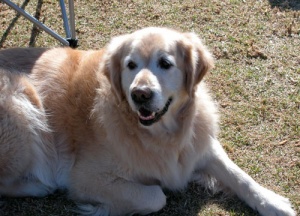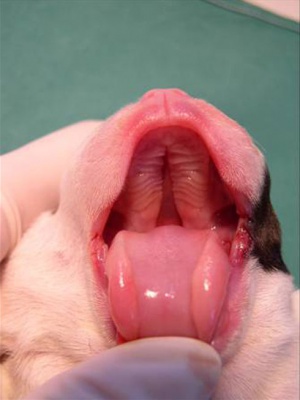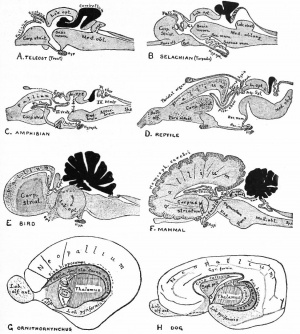Dog Development - Abnormalities
| Embryology - 27 Apr 2024 |
|---|
| Google Translate - select your language from the list shown below (this will open a new external page) |
|
العربية | català | 中文 | 中國傳統的 | français | Deutsche | עִברִית | हिंदी | bahasa Indonesia | italiano | 日本語 | 한국어 | မြန်မာ | Pilipino | Polskie | português | ਪੰਜਾਬੀ ਦੇ | Română | русский | Español | Swahili | Svensk | ไทย | Türkçe | اردو | ייִדיש | Tiếng Việt These external translations are automated and may not be accurate. (More? About Translations) |
Introduction
The domestic dog (Canis lupus familiaris) has been derived from an ancestoral wolf and now consists of a breed family of more than 300 worldwide, with extensive variations in morphology (size, shape and weight). The modern dog breeds show high phenotypic diversity and are thought to have arisen from this first population bottleneck associated with wolf domestication (7,000–50,000 generations ago) and a second from more recent intensive selection to create the breed (50–100 generations ago).[1] The average canine gestation period from ovulation to birth (parturition) is approximately 64 days.
There have been identified about 400 congenital disorders relating to dog development. Many of these developmental abnormalities are common to human development. The list below links to information on the Online Mendelian Inheritance in Animals.
- Dog Links: Dog Development | Dog Abnormalities | Online Mendelian Inheritance in Animals | Search for Canis familiaris
| Animal Development: axolotl | bat | cat | chicken | cow | dog | dolphin | echidna | fly | frog | goat | grasshopper | guinea pig | hamster | horse | kangaroo | koala | lizard | medaka | mouse | opossum | pig | platypus | rabbit | rat | salamander | sea squirt | sea urchin | sheep | worm | zebrafish | life cycles | development timetable | development models | K12 |
External Links Notice - The dynamic nature of the internet may mean that some of these listed links may no longer function. If the link no longer works search the web with the link text or name. Links to any external commercial sites are provided for information purposes only and should never be considered an endorsement. UNSW Embryology is provided as an educational resource with no clinical information or commercial affiliation.
Cardiovascular
Heart
- Atrial septal defect in dog
- Atrial fibrillation in dog
- Cardiomyopathy in dog
- Cardiomyopathy, hypertrophic in dog
- Cardiomyopathy, dilated in dog
- Cardiovascular malformations in dog
- Conotruncal heart malformations in dog
- Heart disease, hypertrophic in dog
- Heart defect, congenital in dog
- Heart disease, hypertrophic in dog
- Polymicrogyria and asymmetrical ventricular dilation in dog
- Mitral valve disease in dog
- Mitral stenosis in dog
- Right ventricular cardiomyopathy in dog
- Persistent truncus arteriosus in dog
- Tetralogy of fallot in dog
- Tricuspid valve dysplasia in dog
- Valvular pulmonic stenosis in dog
- Ventricular arrhythmias and sudden death in dog
- Ventricular septal defect in dog
Blood

- Anaemia, congenital hypoplastic, of Blackfan and Diamond in dog
- Blood group system Tr in dog
- Blood group system D in dog
- Blood group system in dog
- Blood group system Rh in dog
- Bleeding disorder in dog
- C3 deficiency in dog
- Factor XII deficiency in dog
- Factor XI deficiency in dog
- Factor X deficiency in dog
- Factor VII deficiency in dog
- Haemophilia A in dog
- Haemophilia B in dog
- Megakaryoblastic leukaemia in dog
- Von Willebrand disease III in dog
- Von Willebrand disease I in dog
- Von Willebrand disease in dog
Immune
- Immunoglobulin A glomerulonephropathy in dog
- Immunoglobulin A deficiency in dog
- Immunodeficiency in dog
Cleft Lip and Palate
Endocrine
- Adrenal cortical atrophy in dog
- Goitre, familial in dog
- Cushing disease in dog
- Diabetes mellitus in dog
- Diabetes insipidus in dog
- Diabetes in dog
- Hyperadrenocorticism in dog
- Hyperparathyroidism in dog
- Hypogonadism in dog
- Hypoadrenocorticism, primary in dog
- Hypoadrenocorticism in dog
- Thyroiditis in dog
Gastrointestinal Tract
- Achalasia of the oesophagus, congenital in dog
- Gallbladder mucoceles in dog
- Gastric dilatation volvulus syndrome in dog
- Glycogen storage disease VII in dog
- Glycogen storage disease II in dog
- Glycogen storage disease I in dog
- Glycogen storage disease in dog
- Hepatic fibrosis, idiopathic in dog
- Hepatitis, neonatal in dog
- Hepatitis, chronic active in dog
- Imperforate anus with rectovaginal fistula in dog
- Intestinal cobalamin malabsorption in dog
- Inborn error of hepatic metabolism in dog
- Oesophageal motility disorder in dog
Integumentary
- Black hair follicle dysplasia in dog
- Coat colour, merle in dog
- Coat colour, albinism in dog
- Coat colour in dog
- Coat colour, dominant white in dog
- Coat colour, brown in dog
- Coat colour, extension in dog
- Coat length in dog
- Dermatomyositis in dog
- Dermatitis, atopic in dog
- Dermatosis in dog
- Disorder of cornification in dog
- Epidermolysis bullosa, dystrophic in dog
- Epidermolysis bullosa in dog
- Hair length in dog
- Keratitis in dog
- Neoplasia, mammary gland in dog
Musculoskeletal
Bone
- Acetabular dystrophy in dog
- Acromegaly in dog
- Calcification of intervertebral discs in dog
- Ehlers-Danlos syndrome in dog
- Hemivertebrae in dog
- Hip dysplasia in dog
- Osteoarthritis in dog
- Osteogenesis imperfecta in dog
- Osteochondrosis dissecans in dog
- Osteochondrosis in dog
- Osteochondroma causing progressive posterior paresis in dog
- Osteochondritis dissecans in dog
- Osteogenesis imperfecta Dachshund in dog
- Scoliosis in dog
- Short spine in dog
- Vitamin D-deficiency rickets, type I in dog
- Vitamin D-deficiency rickets, type II in dog
Cartilage
Hernia
- Hernia, umbilical in dog
- Hernia, oesophageal hiatal in dog
- Hernia, inguinal in dog
- Hernia, hiatal in dog
- Hernia, diaphragmatic in dog
- Hernia in dog
- Hernia, perineal in dog
Limb
- Brachydactyly in dog
- Carpal subluxation in dog
- Ectrodactyly in dog
- Elbow subluxation in dog
- Elbow luxation in dog
- Elbow dysplasia in dog
- Elbow disease in dog
- Polydactyly in dog
Muscle
- Masticatory muscle myositis in dog
- Myasthenic syndrome, congenital in dog
- Myasthenia gravis in dog
- Muscular dystrophy, dysphagia-associated in dog
- Muscular dystrophy, Duchenne and Becker types in dog
- Muscular dystrophy in dog
- Muscular atrophy, spinal in dog
- Myopathy, progressive, subacute in dog
- Myopathy, mitochondrial in dog
- Myopathy, congenital in dog
Neural
- Amyloidosis in dog
- Alzheimer disease in dog
- Arnold-Chiari malformation in dog
- Neuronal Ceroid Lipofuscinosis, Ceroid Lipofuscinosis in dog
- Cerebellar hypoplasia in dog
- Cerebellar abiotrophy in dog
- Cerebellar Purkinje cell degeneration in dog
- Cauda equina syndrome in dog
- Neuronal ceroid lipofuscinosis, 6 in dog
- Neuronal ceroid lipofuscinosis, adult-onset, Tibetan Terrier in dog
- Encephalomyelopathy and polyneuropathy in dog
- Neuronal ceroid lipofuscinosis, 8 in dog
- Neuronal ceroid lipofuscinosis, 5 in dog
- Neuronal ceroid lipofuscinosis, 10 in dog
- Neuronal ceroid lipofuscinosis, 1 in dog
- Neuronal ceroid lipofuscinosis, 4A in dog
- Neuronal ceroid lipofuscinosis, 2 in dog
- Neonatal encephalopathy with seizures in dog
- Sensory ataxic neuropathy in dog
- Motor neuron disease, lower in dog
- Neuronal vacuolar disorder in dog
- Polyneuropathy in dog
- Motor neuron disease in dog
- Encephalomyelopathy and polyneuropathy in dog
- Hypomyelination of the central nervous system in dog
Renal
- Renal disease in dog
- Renal cystadenocarcinoma and nodular dermatofibrosis in dog
- Renal hypoplasia, bilateral in dog
- Renal dysplasia in dog
- Renal nephropathy in dog
- Renal insufficiency in dog
- Amyloidosis, renal in dog
- Renal cystadenocarcinoma and nodular dermatofibrosis in dog
- Polycystic kidney disease in dog
- Nephritis, autosomal dominant in dog
- Nephritis, X-linked in dog
- Keratitis in dog
Sensory
Hearing
Vision
- Eye defects in dog
- Dry eye curly coat syndrome in dog
- Eye colour in dog
- Progressive retinal atrophy, X-linked, 2 in dog
- Progressive retinal atrophy, X-linked, 3 in dog
- Progressive retinal atrophy, X-linked in dog
- Collie eye anomaly in dog
- Progressive retinal atrophy, SLC4A3 in dog
- Progressive retinal atrophy, Schapendoes in dog
- Cone-rod dystrophy 3 in dog
- persistent hyaloid remnants in dog
- Retinal dystrophy in dog
- Retinal dysplasia in dog
- Rod-cone degeneration, progressive in dog
- Retinal degeneration, early in dog
- Retinal pigment epithelial dystrophy in dog
- Retinal and skeletal dysplasia in dog
- Retinal degeneration II in dog
- Progressive retinal atrophy, X-linked in dog
- Progressive retinal atrophy in dog
- Dwarfism with retinal dysplasia in dog
X-Linked
- Progressive retinal atrophy, X-linked, 2 in dog
- Progressive retinal atrophy, X-linked, 3 in dog
- Nephritis, X-linked dominant in dog
- Sex reversal: XX male in dog
- Tremor, X-linked in dog
- Severe combined immunodeficiency disease, X-linked in dog
- Progressive retinal atrophy, X-linked in dog
- Nephritis, X-linked in dog
- Links: X Chromosome
Dog Abnormalities List
Infection
Canine Hepatozoonosis
Canine_hepatozoonosis[3]
The genus Hepatozoon includes hundreds of species that infect birds, reptiles, amphibians and mammals, in all continents with tropical and subtropical climates. Hepatozoon canis was first described in the early 1900s.
- Links: Zoonotic Infection
References
- ↑ <pubmed>16341006</pubmed>
- ↑ <pubmed>22052005</pubmed>| PMC3275728 | Mamm Genome.
- ↑ <pubmed>21961746</pubmed>| Rev Bras Parasitol Vet.
External Links
External Links Notice - The dynamic nature of the internet may mean that some of these listed links may no longer function. If the link no longer works search the web with the link text or name. Links to any external commercial sites are provided for information purposes only and should never be considered an endorsement. UNSW Embryology is provided as an educational resource with no clinical information or commercial affiliation.
- Online Mendelian Inheritance in Animals | Search for Canis familiaris
- University of Georgia College of Veterinary Medicine The Canine Estrous Cycle
- Comparative Placentation Dog
| Animal Development: axolotl | bat | cat | chicken | cow | dog | dolphin | echidna | fly | frog | goat | grasshopper | guinea pig | hamster | horse | kangaroo | koala | lizard | medaka | mouse | opossum | pig | platypus | rabbit | rat | salamander | sea squirt | sea urchin | sheep | worm | zebrafish | life cycles | development timetable | development models | K12 |
Glossary Links
- Glossary: A | B | C | D | E | F | G | H | I | J | K | L | M | N | O | P | Q | R | S | T | U | V | W | X | Y | Z | Numbers | Symbols | Term Link
Cite this page: Hill, M.A. (2024, April 27) Embryology Dog Development - Abnormalities. Retrieved from https://embryology.med.unsw.edu.au/embryology/index.php/Dog_Development_-_Abnormalities
- © Dr Mark Hill 2024, UNSW Embryology ISBN: 978 0 7334 2609 4 - UNSW CRICOS Provider Code No. 00098G



